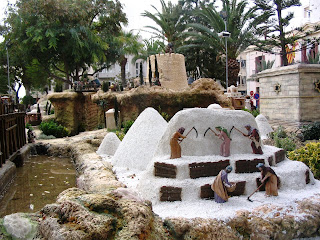 It's 7:30 AM and I awoke to the birds chirping two hours ago. We were downstairs early, even before there was full daylight, eating breakfast in the small sunroom/entrance to our house. This was to be Goldie's big day.
It's 7:30 AM and I awoke to the birds chirping two hours ago. We were downstairs early, even before there was full daylight, eating breakfast in the small sunroom/entrance to our house. This was to be Goldie's big day.We had kept our cat inside for five days so she could adjust to her new home and recover from the terror of moving once again, cracking the windows slightly open to let the smells enter into her unconscious memory but prevent her from squeezing out, and suffering ourselves from lack of fresh air and cross breezes. Yesterday had been particularly terrifying for Goldie, with all the noise of drilling to admit cable and men crawling on the roofs and clattering up and down stairs. Goldie spent yesterday morning cowering in a corner of the downstairs office, well protected by boxes of books and miscellanea.
This morning at 6:30 we slid the glass door wider open than the inch or two that she had been nosing at, and soon she was out the door. Not running and dancing for joy--she stopped on the top step and looked behind, seeming to inquire why we weren't after her to scold her or bring her back in. We sat tight, and she proceeded down the other stair step, then walked over to the yucca plant and sniffed. Soon she proceeded to the pineapple palm, and then she reversed direction and walked around to the other side of the front room and nosed around the plantings there next to the three-person outdoor seating area. The next thing we knew, she had hopped over the greenery to the garden path leading down to a couple houses behind our property. We left her to explore and went about our morning routines.
At 7:00 I heard a loud continuous noise and walked out on the rooftop terrace to investigate. A large piece of vehicular machinery with a flashing yellow light was coming down Avenida del Tomillo. As it got closer, I realized it was washing the street. Ah, perhaps every Wednesday is street-cleaning day. I'll try to remember that next week so we can park the car inside the gate instead of leaving it on the street. The machine and the person driving it didn't seem to mind, however, as they maneuvered around several cars on the street. The dog on the other side of the street didn't appreciate the invasion, though, and who knows what Goldie was thinking about yet more noise?
I went downstairs to see if she had made her return appearance yet. We had left the glass door to the sunroom open, but closed and locked the grating on the front door of the house. (Locks, keys, door and window grills and grating are a major fact of life in Spain--we have four keys to go through just to get into our living room.) I saw Goldie outside the sunroom, sniffing at the bougainvillea. Then I turned my back, asked a question, and went into the kitchen for another cup of coffee. I came out and looked from the living room through the grate and sunroom, and whistled to try to encourage her to come inside. And she appeared, totally unexpectedly, from behind me in the house! She can walk easily through the spaces in the grating.
For coming home promptly, of course, she got a special treat. If she continues to get rewarded each time she goes out and returns, she may soon not be able to fit through the grating.







